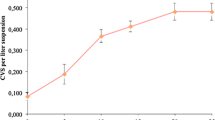Abstract
The effects of heavy metal ions (Co2+, Ag+, Cd2+) on cell viability and secondary metabolite production, particularly anthocyanins and phenolic acids in Vitis vinifera cell suspension cultures, were investigated. Of these, Co at all three used concentrations (5.0, 25, and 50 μM), Ag, and Cd at low concentration (5.0 μM) were most effective to stimulate the phenolic acid production, increasing the 3-O-glucosyl-resveratrol up to 1.6-fold of the control level (250.5 versus 152.4 μmol/g), 4 h after the treatments. Meanwhile, the elicitors at effective concentrations did not suppress cell growth, while the cell viability maintained. In contrast, Ag and Cd at high concentrations (25 and 50 μM) remarkably reduced the cell viability, decreasing the cell viability up to about 15 % of the control level, 24 h after the treatments. The heavy metal ions did not affect the anthocyanin production. These observations show how, in a single system, different groups of secondary products can show distinct differences in their responses to potential elicitors. The 1,1-diphenyl-2-picrylhydrazyl radical scavenging activity, peroxidase activity, medium pH value, and conductivity were only slightly elevated by the heavy metal ions. The results suggest that some of the secondary metabolites production was stimulated by the used elicitors, but there was not a stress response of the cells.




Similar content being viewed by others
References
Hanchinal, V. M., Survase, S. A., Sawant, S. K., & Annapure, U. S. (2008). Plant Cell, Tissue and Organ Culture, 93, 123–132.
Krolicka, A., Szpitter, A., Stawujak, K., Baranski, R., Gwizdek-Wisniewska, A., Skrzypczak, A., et al. (2010). Plant Cell, Tissue and Organ Culture, 103, 285–292.
Fu, C. X., Cheng, L. Q., Lv, X. F., Zhao, D. X., & Ma, F. S. (2006). Applied Biochemistry and Biotechnology, 134, 89–96.
Gandi, S., Rao, K., Chodisetti, B., & Giri, A. (2012). Applied Biochemistry and Biotechnology, 168, 1729–1738.
Shumakova, O. A., Manyakhin, A. Y., & Kiselev, K. V. (2011). Applied Biochemistry and Biotechnology, 165, 1427–1436.
Maksymiec, W. (2007). Acta Physiologiae Plantarum, 29, 177–187.
Zhang, C. H., Yan, Q., Cheuk, W. K., & Wu, J. Y. (2004). Planta Medica, 70, 147–151.
Zhao, J. L., Zhou, L. G., & Wu, J. Y. (2010). Applied Microbiology and Biotechnology, 87, 137–144.
Ge, X., & Wu, J. (2005). Plant Science, 168, 487–491.
Khosroushahi, A. Y., Valizadeh, M., Ghasempour, A., Khosrowshahli, M., Naghdibadi, H., Dadpour, M. R., et al. (2006). Cell Biology International, 30, 262–269.
Furze, J. M., Rhodes, M. J. C., Parr, A. J., Robins, R. J., Withehead, I. M., & Threlfall, D. R. (1991). Plant Cell Reports, 10, 111–114.
Murch, S. J., Haq, K., Rupasinghe, H. P. V., & Saxena, P. K. (2003). Environmental and Experimental Botany, 49, 251–257.
Cai, Z., Knorr, D., & Smetanska, I. (2012). Enzyme and Microbial Technology, 50, 29–34.
Gamborg, O. L., Miller, R. A., & Ojima, K. (1968). Experimental Cell Research, 50, 151–158.
Towill, L. E., & Mazur, P. (1975). Canadian Journal of Botany, 53, 1097–1102.
Mewis, I., Smetanska, I., Müller, C., & Ulrichs, C. (2011). Applied Biochemistry and Biotechnology, 164, 148–161.
Mohdaly, A. A. A., Sarhan, M. A., Smetanska, I., & Mahmoud, A. (2010). Journal of the Science of Food and Agriculture, 90, 218–226.
Kombrink, E., & Somssich, I. E. (1995). Advances in Botanical Research, 21, 1–34.
Yesil-Celiktas, O., Nartop, P., Gurel, A., Bedir, E., & Vardar-Sukan, F. (2007). Journal of Plant Physiology, 164, 1536–1542.
Bowles, D. J. (1990). Annual Review of Biochemistry, 59, 873–907.
Kwak, S.-S., Kim, S.-K., Park, I.-H., & Liu, J. R. (1996). Phytochemistry, 43, 565–568.
Do, C. B., & Cormier, F. (1991). Plant Cell, Tissue and Organ Culture, 24, 49–54.
Cai, Z., Riedel, H., Thaw Saw, N., Kütük, O., Mewis, I., Jäger, H., et al. (2011). Applied Biochemistry and Biotechnology, 164, 443–453.
Cai, Z., Riedel, H., Saw, N. M. M. T., Mewis, I., Reineke, K., Knorr, D., et al. (2011). Process Biochemistry, 46, 1411–1416.
Chakraborty, M., Karun, A., & Mitra, A. (2009). Journal of Plant Physiology, 166, 63–71.
Sircar, D., & Mitra, A. (2008). Journal of Plant Physiology, 165, 407–414.
Gadzovska, S., Maury, S., Delaunay, A., Spasenoski, M., Joseph, C., & Hagege, D. (2007). Plant Cell, Tissue and Organ Culture, 89, 1–13.
van der Plas, L. H. W., Eijkelboom, C., & Hagendoorn, M. J. M. (1995). Plant Cell, Tissue and Organ Culture, 43, 111–116.
Ferrat, L., Pergent-Martini, C., & Romeo, M. (2003). Aquatic Toxicology, 65, 187–204.
Baque, M. A., Lee, E. J., & Paek, K. Y. (2010). Plant Cell Reports, 29, 685–694.
Cui, X. H., Murthy, H. N., Wu, C. H., & Paek, K. Y. (2010). Plant Cell, Tissue and Organ Culture, 103, 7–14.
Yamaguchi, T., Fujita, K., & Sakai, K. (1999). Journal of Wood Science, 45, 170–173.
Messner, B., & Boll, M. (1993). Plant Cell, Tissue and Organ Culture, 34, 261–269.
Meloni, D. A., Oliva, M. A., Martinez, C. A., & Cambraia, J. (2003). Environmental and Experimental Botany, 49, 69–76.
Acknowledgments
We wish to thank Prof. Dietrich Knorr from Technical University Berlin for supporting this work. We also thank Irene Hemmerich from Technical University Berlin for providing V. vinifera cell culture and the continuous cultivation.
Author information
Authors and Affiliations
Corresponding author
Rights and permissions
About this article
Cite this article
Cai, Z., Kastell, A., Speiser, C. et al. Enhanced Resveratrol Production in Vitis vinifera Cell Suspension Cultures by Heavy Metals Without Loss of Cell Viability. Appl Biochem Biotechnol 171, 330–340 (2013). https://doi.org/10.1007/s12010-013-0354-4
Received:
Accepted:
Published:
Issue Date:
DOI: https://doi.org/10.1007/s12010-013-0354-4




